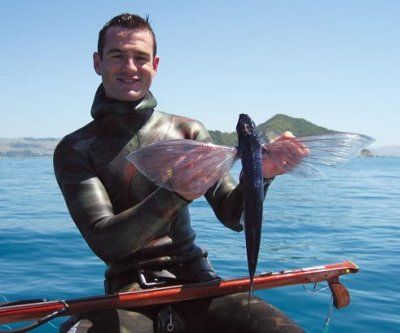COMMON NAME
Flying Fish
SCIENTIFIC NAME
Cypselurus Lineatus
LEGAL LENGTH & LIMITS
No legal length
DESCRIPTION
Flying fish can be seen jumping out of waters worldwide. Their streamlined torpedo shaped bodies helps them gather enough speed underwater to break the surface, and their large, wing-like pectoral fins get them airborne.
Their most striking feature is their pectoral fins which are unusually large, and enable the fish to hide and escape from predictors by leaping out of the water, taking short glided flights through air just above the water's surface. Their glides are typically around 50 m, but they can use up-drafts at the leading edge of waves to cover distances of at least 400 m. Their predators include mackerel, tuna, swordfish, marlin, and other larger fish.
There are about 40 known species of flying fish. Beyond their useful pectoral fins, all have unevenly forked tails, with the lower lobe longer than the upper lobe. Many species have enlarged pelvic fins as well and are known as four-winged flying fish.
The process of taking flight, or gliding, begins by gaining great velocity underwater, about 60 kilometers per hour. Angling upward, the four-winged flying fish breaks the surface and begins to taxi by rapidly beating its tail while it is still beneath the surface. It then takes to the air, sometimes reaching heights over 1.2 meters and gliding long distances, up to 200 meters. Once it nears the surface again, it can flap its tail and taxi without fully returning to the water. Capable of continuing its flight in such a manner, flying fish have been recorded stretching out their flights with consecutive glides spanning distances up to 400 meters.
HABITAT & FEEDING
Flying fish occur in offshore surface waters around northern New zeal ands. they are also found in all of the major oceans, particularly in the warm tropical and subtropical waters of the alantic ocean, pacific and Indian oceans.
Flying Fish feed mainly on plankton. They also eat invertebrates and zoo-plankton crustaceans. Feed mostly at night.
AGE & GROWTH
Male flying fish are 3times more abundant than females. But little is known about there are and growth.
FOOD QUALITY
Flying fish are fished commercial overseas but not often targeted by spearos. They have a soft flesh and are often just scaled and fried
HUNTING TECHNIQUES
Flying fish are attracted to the light of torches and not often targeted by spearfisherman
Flying fish are commercially fished in Japan Vietnam and Barbados by the method of gill netting and in Indonesia and India by dip netting In Solomon islands they are caught while flying, using nets in the air, held from outrigger canoes.



